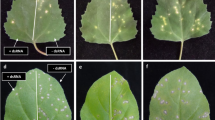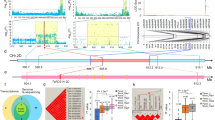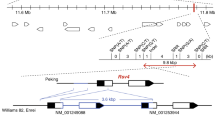Abstract
For a growing number of positive–strand RNA viruses, it has been demonstrated that transformation of host plants with the viral coat protein gene confers resistance to the corresponding virus. Thus far, successful transformation strategies to obtain resistance to negative–strand RNA viruses have not been reported. Here we show that genetically engineered resistance can be obtained to tomato spotted wilt virus, an enveloped virus with a negative–strand RNA genome, by transforming tobacco with the gene encoding the viral nucleocapsid protein, an internal RNA–binding protein. This approach may be useful for producing plants resistant to infection by other negative–strand viruses.
This is a preview of subscription content, access via your institution
Access options
Subscribe to this journal
Receive 12 print issues and online access
$209.00 per year
only $17.42 per issue
Buy this article
- Purchase on Springer Link
- Instant access to full article PDF
Prices may be subject to local taxes which are calculated during checkout
Similar content being viewed by others
References
Sakimura, K. 1962. The present status of thrips-borne viruses, p. 33–40. In: Biological Transmission of Disease Agents. K. Maramorosch (Ed.). Academic Press, NY.
Paliwal, Y.C. 1974. Some properties and thrips transmission of tomato spotted wilt virus in Canada. Can. J. Bot. 52: 1177–1182.
Best, R.J. and Palk, B.A. 1964. Electron microscopy of strain E of tomato spotted wilt virus and comments on its probable biosynethesis. Virology 23: 445–460.
Ie, T.S. 1964. An electron microscope study of tomato spotted wilt virus in the plant cell. Neth. J. Plant Pathol. 70: 114–115.
Kitajima, E.W. 1965. Electron microscopy of vira-cabeca virus (Brazilian tomato spotted wilt virus) within the host cell. Virology 26: 89–99.
Van den Hurk, J., Tas, P.W.L. and Peters, D. 1977. The ribonucleic acid of tomato spotted wilt virus. J. Gen. Virol. 36: 81–91.
Mohamed, N.A. 1981. Isolation and characterization of subviral structures from tomato spotted wilt virus. J. Gen. Virol. 53: 197–206.
Peters, D., Avila, A.C. de, Kitajima, E.W., Resende, R. de O., De Haan, P. and Goldbach, R. 1991. An overview of tomato spotted wilt virus, p. 1–14. In: Virus-Thrips-Plant Interactions of TSWV, Proc. USDA workshop, Beltsville, MD. H-.T. Hsu and R. H. Lawson, (Eds.). Nat. Tech. Inf. Serv. Springfield, VA.
De Haan, P., Wagemakers, L., Peters, D. and Goldbach, R. 1990. The S RNA segment of tomato spotted wilt virus has an ambisense character. J. Gen. Virol. 71: 1001–1007.
Giorgi, C., Accardi, L., Nicoletti, L., Gro, M.C., Takehara, K., Hilditch, C., Morikawa, S. and Bishop, D.H.L. 1991. Sequences and coding strategies of the S RNAs of Toscana and Rift Valley fever viruses compared to those of Punta Toro, Sicilian sandfly fever, and Uukuniemi viruses. Virology 180: 738–753.
De Haan, P., Kormelink, R., Resende, R. de O., Van Poelwijk, F., Peters, D. and Goldbach, R. 1991. Tomato spotted wilt virus L RNA encodes a putative RNA polymerase. J. Gen. Virol. 71: 2207–2216.
Elliott, R.M. 1990. Molecular biology of the Bunyaviridae. J. Gen. Virol. 71: 501–522.
Iwaki, M., Honda, Y., Hanada, K., Tochihara, H., Yonaha, T., Hokama, K. and Yokohama, T. 1984. Silver mottle disease of watermelon caused by tomato spotted wilt virus. Plant Dis. 68: 1006–1008.
Barnes, L.W. and Halliwell, R.S. 1985. Tomato spotted wilt virus infecting begonia hybrids in Texas. Plant Dis. 69: 613.
Reddick, B.B., Hadden, C.H., Bost, S.C. and Newman, M.A. 1987. First report of tomato spotted wilt virus in Tennessee. Plant Dis. 71: 376.
Allen, W.R. and Matteoni, J.A. 1988. Cyclamen ringspot: Epidemics in Ontario greenhouses caused by the tomato spotted wilt virus. Can. J. Plant Pathol. 10 : 41–46.
Brown, L.G. 1988. Tomato spotted wilt virus in ornamentals. Plant Pathol. circ. 313.
Mantel, W.P. and Van de Vrie, M. 1988. The Western flower thrips Frankliniella occidentalis, a new thrips species causing damage in protected cultures in the Netherlands. Ent. Ber., Amst. 48: 140–144.
Gebré-Selassie, K., Chabriere, C. and Marchoux, G. 1989. Un virus qui se réveille. Phytoma 410: 30–35.
Cho, J.J., Mau, R.F.L., Gonsalves, D. and Mitchell, W.C. 1986. Reservoir weed hosts of tomato spotted wilt virus. Plant Dis. 70: 1014–1017.
Smith, P.G. and Gardner, M.W. 1951. Resistance in tomato to the spotted wilt virus. Phytopathology 41: 257–260.
Finlay, K.W. 1953. Inheritance of spotted wilt resistance in the tomato. Austr. J. Biol. Sci. 6: 153–163.
Borchers, E.A. 1956. A study of the nature of resistance of the Mignonette variety of lettuce to the tomato spotted wilt virus. PhD. Thesis, University of California. Davis, California.
Holmes, F.O. 1958. A single-gene resistance test for viral relationship as applied to strains of spotted wilt virus. Virology 5: 382–390.
Best, R.J. 1968. Tomato spotted wilt virus. Adv. Virus Res. 13: 65–145.
Moldovan, M.YA. and Chokan, N.G. 1972. Resistance of wild species of Nicotiana to spotted wilt (Lycopersicon virus 3 (Smith)). Izv. Akad. Nauk Mold. SSR. Ser. Biol. Khim. Nauk 1972: 38–44.
Vinogradov, V.A., Trofimova, L.I. and Sarychev, Y.F. 1982. Field resistance of varieties, hybrids and chemical mutants of tobacco to tobacco thrips and tomato spotted wilt virus. Tabak 1982: 43–44, no. 3.
Cupertino, F.P., Avila de, A.C., Araujo, M.T. and Maluf, W.R. 1986. Sources of resistance to tomato spotted wilt virus in Lycopersicon. Fitopatologia Brasileira 11: 330–331.
O'Malley, P.J. and Hartmann, R.W. 1989. Resistance to tomato spotted wilt virus in lettuce. Hort. Science 24: 360–362.
Paterson, R.G., Scott, S.J. and Gergerich, R.C. 1989. Resistance in two Lycopersicon species to an Arkansas isolate of tomato spotted wilt virus. Euphytica 43: 173–178.
Ihara, T., Matsuura, Y. and Bishop, D.H.L. 1985. Analyses of the mRNA transcription processes of Punta Toro phlebovirus (Bunyaviridae). Virology 147: 317–325.
Beaton, A.R. and Krug, R.M. 1986. Transcription antitermination during influenza virus template RNA synthesis requires the nucleocapsid protein and the absence of a 5′ capped end. Proc. Natl. Acad. Sci. USA. 83: 6282–6286.
Franze-Fernandez, M.T., Zetina, C., Iapalucci, S., Lucero, M.A., Bouissou, C., Lopez, R., Rey, O., Daheli, M., Cohen, G.N. and Zakin, M.M. 1987. Molecular structure and early events in the replication of Tacaribe arenavirus S RNA. Virus Res. 7: 309–324.
Vidal, S. and Kolakofski, D. 1989. Modified model for the switch from Sendai virus transcription to replication. J. Virol. 63: 1951–1958.
Gallie, D.R., Sleat, D.E., Watts, J.W., Turner, P.C. and Wilson, T.M.A. 1987. A comparison of eukaryotic viral 5′-leader sequences as enhancers of mRNA expression in vivo. Nucl. Acid Res. 15: 8693–8711.
Avila, A.C. de Huguenot, C., Resende, R. de O., Kitajima, E.W., Goldbach, R.W. and Peters, D. 1990. Serological differentiation of 20 isolates of tomato spotted wilt virus. J. Gen. Virol. 71: 2801–2807.
Benfey, P.N., Ren, L. and Chua, N.-H. 1989. Tissue-specific expression from CaMV 35S enhancer subdomains in early stages of plant development. EMBO J. 9: 1677–1684.
Benfey, P.N., Ren, L. and Chua, N.-H. 1989. Combinatorial and synergistic properties of CaMV 35S subdomains. EMBO J. 9: 1685–1696.
Beachy, R.N., Loesch-Fries, S. and Tumer, N.E. 1990. Coat protein-mediated resistance against virus infection. Ann. Rev. Phytopathol. 28: 451–474.
Hemenway, C., Haley, L., Kaniewski, W.K., Lawson, E.C., O'Connell, K.M., Sanders, P.R., Thomas, P.E. and Tumer, N.E. 1990. Genetically engineered resistance: transgenic plants, p. 347–362. In: Plant Viruses. Vol. 2: Pathology. C. L. Mandahar, (Ed.). CRC Press, Boca Raton, FL.
Tas, P.W.L., Boerjan, M.L. and Peters, D. 1977. The structural proteins of tomato spotted wilt virus. J. Gen. Virol. 36: 267–279.
Ausubel, F.A., Brent, R., Kingston, R.E., Moore, D.D., Seidman, J.G., Smith, J.A. and Struhl, K. (Eds.). 1990. Current Protocols in Molecular Biology. Green Publishing and Wiley-Interscience, NYC, NY.
Bevan, M. 1984. Binary Agrobacterium vectors for plant transformation. Nucl. Acids Res. 12: 8711–8721.
Hoekema, A., Hirsch, P.R., Hooykaas, P.J.J. and Schilperoort, R.A. 1983. A binary vector system based on separation of vir and T- region of the Agrobacterium tumefaciens Ti-plasmid. Nature 303: 179–180.
Ditta, G., Stanfield, S., Corbin, D. and Helinski, D.R. 1980. Broad host range DNA cloning system for Gram-negative bacteria: construction of a gene bank of Rhizobium meliloti. Proc. Natl. Acad. Sci. USA. 80: 7347–7351.
Horsch, R.B., Fry, J.E., Hoffman, N.L., Eichholtz, D., Rogers, S.G. and Fraley, R.T. 1985. A simple and general method for transferring genes into plants. Science 227: 1229–1231.
Logemann, J., Schell, J. and Willmitzer, L. 1987. Improved method for the isolation of RNA from plant tissues. Anal. Biochem. 163: 16–20.
Resende, R. de O., Avila, A.C. de, Goldbach, R.W. and Peters, D. 1991. Detection of tomato spotted wilt virus using polyclonal antisera in double antibody sandwich (DAS) ELISA and cocktail ELISA. J. Phytopathol. 132: 46–56.
Laemmli, U.K. 1970. Cleavage of structural proteins during the assembly of the head of bacteriophage T4. Nature 227: 680–685.
Ie, T.S. 1970. Tomato spotted wilt virus. CMI/AAB Descr. of Plant Viruses 39.
Francki, R.I.B., Milne, R.G. and Hatta, T. 1985. Atlas of Plant Viruses, Vol. 1. CRC Press, Boca Raton, FL.
Author information
Authors and Affiliations
Rights and permissions
About this article
Cite this article
Gielen, J., de Haan, P., Kool, A. et al. Engineered Resistance to Tomato Spotted Wilt Virus, a Negative–Strand RNA Virus. Nat Biotechnol 9, 1363–1367 (1991). https://doi.org/10.1038/nbt1291-1363
Received:
Accepted:
Issue Date:
DOI: https://doi.org/10.1038/nbt1291-1363
This article is cited by
-
Screening of a multi-virus resistant RNAi construct in cowpea through transient vacuum infiltration method
VirusDisease (2019)
-
Untranslatable tospoviral NSs fragment coupled with L conserved region enhances transgenic resistance against the homologous virus and a serologically unrelated tospovirus
Transgenic Research (2015)
-
Use of silencing reporter and agroinfiltration transient assays to evaluate the potential of hpRNA construct to induce multiple tospovirus resistance
Biologia plantarum (2015)
-
Pathogen-derived resistance using a viral nucleocapsid gene confers only partial non-durable protection in peanut against peanut bud necrosis virus
Archives of Virology (2013)
-
Resistance to a DNA and a RNA virus in transgenic plants by using a single chimeric transgene construct
Transgenic Research (2011)



